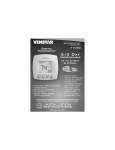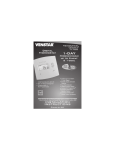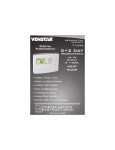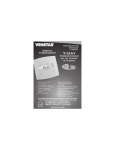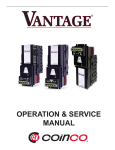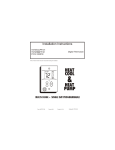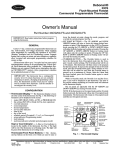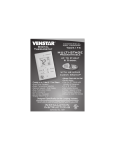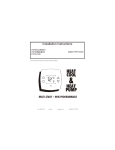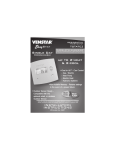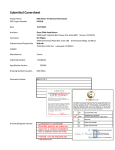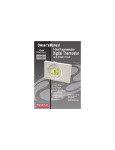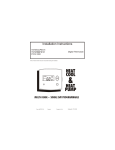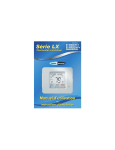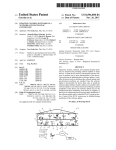Download Venstar T2300FS Owner`s manual
Transcript
residential Digital Thermostat THERMOSTAT T2300FS 7-Day PROGRAMMABLE up to 2-heat & 2-cool HEAT COOL Control up to 2 Heat & 2 Cool Stages 7-Day Programmable 4 Settings/Day Auto Changeover 5 minute Built-In Compressor Protection Self-Prompting Programming with Copy Command Display Either F or C HEAT PUMP Mounts Flush with the Wall Back-Lit display One For All Works with Virtually All Equipment Non-Volatile memory Holiday/Vacation Programming Keypad lockout Dual setpoint with Adjustable Deadband ‘O’ or ‘B’ Terminal Optional: Remote Sensor Ready Dry Contact Equipped Use with most Air Conditioning & Heating Systems including: 1 or 2 Stage Electric Cooling & 2 Stage Gas Heating, Heat Pump, Electric or Hydronic Heat. INSTALLATION INSTRUCTIONS Venstar Inc. 08/07 Table Of Contents Step #1: Preparation 2 Step #2: Remove & Replace Old Thermostat 3 Step #3: Wire Connections 4 Step #4: Test Operation 12 Trouble Shooting 13 CAUTION Follow Installation Instructions carefully. DISCONNECT POWER TO THE HEATER AIR CONDITIONER BEFORE REMOVING THE OLD THERMOSTAT AND INSTALLING THE NEW THERMOSTAT. WARNING Venstar Inc. 08/07 P/N T2300FS This device complies with Part 15 of the FCC rules. Operation is subject to the following two conditions: (1) This device may not cause harmful interference, and (2) this device must accept any interference received, including interference that may cause undesired operation. Page 1 STEP #1 PREPARATION FLATSTAT EXTENDS LESS THAN 3/8” FROM THE WALL. Flat Blade Screwdriver Wire cutter & Stripper .366” Make sure your Heater/Air Conditioner is working properly before beginning installation of the thermostat. Carefully unpack the thermostat. Save the screws, wall anchors, and instructions. Turn off the power to the Heating/Air Conditioning system at the main fuse panel. Most residential systems have a separate breaker for disconnecting power to the furnace. Page 2 FlatStat in Small J-Box WALL Assemble tools & recommended Junction Box. WALL Proper installation of the thermostat will be accomplished by following these step by step instructions. If you are unsure about any of these steps, call a qualified technician for assistance. STEP #2 REMOVE & REPLACE OLD THERMOSTAT Remove the cover of the old thermostat. If it does not come off easily check for screws. Loosen the screws holding the thermostat base or subbase to the wall, and lift away. Disconnect the wires from the old thermostat. Tape the ends of the wires as you disconnect them, and mark them with the letter of the terminal for easy reconnection to the new thermostat. Keep the old thermostat for reference purposes, until your new thermostat is functioning properly. Remove the white plastic wire connector from the rear of the thermostat. Install wires as directed. Press the wired connector on the back of the thermostat. Lift Connector straight up to remove. For best operation, install the thermostat in a junction box that is free from drafts that originate inside the wall. Page 3 STEP #3 WIRE CONNECTIONS If the terminal designations on your old thermostat do not match those on the new thermostat, refer to the chart below, or the wiring diagrams that follow. Wire from the old thermostat terminal marked Function G or F Fan Y1, Y or C Cooling W1, W or H Heating Install on the new thermos tat connector marked G Y1 W1,O,B Rh, R, M, Vr, A Power C Common C* R O/b Rev. Valve W1,O,B** Y2 2nd Stage Cool Y2 W2 2nd Stage Heat W2 RS+5 Remote Sensor +5vdc RS+5 RS Remote Sensor Signal RS RS G Remote Sensor Ground GND CK1 Dry Contact Switch 1 CK1 CK2 Dry Contact Switch 2 GND * C may not be used on all systems. ** O/B is used if your system is a Heat Pump. Page 4 Sample Wiring Diagrams Gas or Electric Heat 5 Wire, 1 Stage Cooling, 1 Stage Gas Heat W FAN G COMPRESSOR COMMON C GAS VALVE or STRIP HEAT Y POWER CK1 GND RS RS+5 W2 Y2 R C G Y1 W1-O-B R Residential Gas or Electric Heat*, Electric Cool, split systems & package units * If using first stage electric heat, this option must be selected ON (see page 16, step 6 of Owner’s Manual). Page 5 Sample Wiring Diagrams Gas or Electric Heat 4 Wire, 1 Stage Cooling, 1 Stage Gas Heat GAS VALVE or STRIP HEAT W COMPRESSOR Y FAN G POWER CK1 GND RS RS+5 W2 Y2 R C G Y1 W1-O-B R Residential Gas or Electric Heat*, Electric Cool, split systems & package units * If using first stage electric heat, this option must be selected ON (see page 16, step 6 of Owner’s Manual). Page 6 Sample Wiring Diagrams Gas or Electric Heat 6 Wire, 2 Stage Cooling, 1 Stage Gas Heat W COMPRESSOR COMMON C 2nd STAGE COOLING Y2 FAN G GAS VALVE or STRIP HEAT Y POWER CK1 GND RS RS+5 W2 Y2 R C G Y1 W1-O-B R Residential two stage cooling with Gas or Electric Heat*. * If using first stage electric heat, this option must be selected ON (see page 16, step 6 of Owner’s Manual). Page 7 Sample Wiring Diagrams Gas or Electric Heat 6 Wire, 1 Stage Cooling, 2 Stage Heat Residential & commercial 1 Stage Cooling, with 2 Stage Gas or Electric Heat* W COMPRESSOR COMMON C 2nd STAGE HEATING W2 FAN G GAS VALVE or STRIP HEAT Y POWER CK1 GND RS RS+5 W2 Y2 R C G Y1 W1-O-B R * If using first stage electric heat, this option must be selected ON (see page 16, step 6 of Owner’s Manual). Page 8 Sample Wiring Diagrams Gas or Electric Heat Commercial Gas or Electric Heat *, Electric Cool, split systems & package units including Commercial Heat Pumps ** 7 Wire, 2 Stage Cooling, 2 Stage Heat W COMPRESSOR COMMON C 2nd STAGE HEATING 2nd STAGE COOLING Y2 W2 FAN G GAS VALVE or STRIP HEAT Y POWER CK1 GND RS RS+5 W2 Y2 R C G Y1 W1-O-B R * If using first stage electric heat, this option must be selected ON (see page 16, step 6 of Owner’s Manual). ** Commercial heat pumps do not have the heat pump turned ON in advanced setup (see page 15, step 4 of Owner’s Manual). Page 9 Sample Wiring Diagrams Heat Pump 5 Wire, 1 Stage Cooling, 1 Stage Heat-Heat Pump* with O or b reversing valve**. Residential Heat Pumps, split systems & package units, with no auxiliary heat. R O/b COMPRESSOR FAN G REVERSING VALVE** COMMON C POWER Y C G Y1 W1-O-B R CK1 GND RS RS+5 W2 Y2 * This option must be selected ON during advanced setup (see page 15, step 4 of Owner’s Manual). ** This option must be selected O or b during advanced setup (see page 16, step 5 of Owner’s Manual). Page 10 Sample Wiring Diagrams Heat Pump 6 Wire, 1 Stage Cooling, 2 Stage Heat-Heat Pump* with O or b reversing valve**. Residential Heat Pumps, split systems & package units, with auxiliary heat. O/b COMPRESSOR COMMON C 2nd STAGE HEATING W2 FAN G REVERSING VALVE** Y POWER CK1 GND RS RS+5 W2 Y2 R C G Y1 W1-O-B R * This option must be selected ON during advanced setup (see page 15, step 4 of Owner’s Manual). ** This option must be selected O or b during advanced setup (see page 16, step 5 of Owner’s Manual). Page 11 STEP #4 TEST OPERATION Turn the power on to the Heating/Air Conditioning system. Press the MODE button repeatedly until the HEAT icon appears on the display. Press the UP or DOWN buttons until the set temperature is 10 degrees above room temperature. The HVAC unit should energize in the heating mode. Press the MODE button repeatedly until the COOL icon appears on the display. Press the UP or DOWN buttons until the set temperature is 10 degrees below room temperature. The HVAC unit should energize in the cooling mode. NOTE: Most equipment has a time delay of 5 minutes between cool cycles. This feature is defeatable on the thermostat (see page 16, step 9 of Owner's Manual). Press the UP button until the set temperature is equal to the room temperature; cooling should deenergize. Follow the instructions on page 15 of the Owner’s Manual to turn the fan on in step 3. The fan should turn on and run continuously. Page 12 TROUBLESHOOTING SYMPTOM: When using 4 wires (R, G, W, Y), the air conditioning equipment tries repeatedly to turn on, but cannot. At times the display dims or disappears. CAUSE: There is not enough power available to "power share". REMEDY: Connect a 250 ohm, 10 watt power resistor at the furnace as shown below. R G W Y C TR300-10w SYMPTOM: The air conditioning does not attempt to turn on. CAUSE: The compressor timer lockout may prevent the air conditioner from turning on, for a period of time. REMEDY: See page 16 of the Owner's Manual and configure step 9 to defeat the 5minute compressor lockout. SYMPTOM: The display is blank. CAUSE: Lack of proper power. REMEDY: Make sure power is turned on to the furnace and 24vac between R & W. If C is used, 24vac between R & C. Page 13 TROUBLESHOOTING SYMPTOM: When controlling a residential heat pump, and asking for cooling, the heat comes on. CAUSE: Heat pump is not selected "ON" in the Advanced Setup. REMEDY: See page 15 of the Owner's Manual and configure step 4 to enable heat pump operation. SYMPTOM: When calling for cooling, both the heat and cool come on. CAUSE: The thermostat is configured to control a heat pump and the HVAC system is a "conventional" (non-heat pump) system. REMEDY: See page 15 of the Owner's Manual and set step 4 to OFF to enable gas electric operation. FlatStat T2300FS c FC Tested to Comply with FCC Standards FOR HOME OR OFFICE USE 4Z95 P/N 88-641 Rev. 1 Page 14















